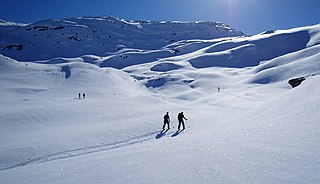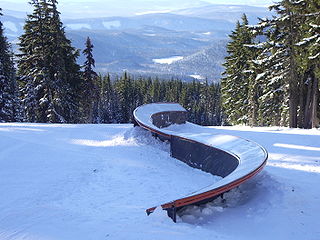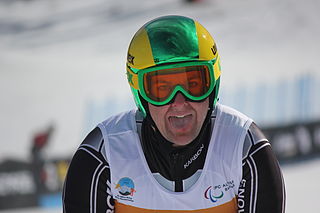
| Skiing techniques |
|---|
The snowplough turn,snowplow turn, or wedge turn [1] is a downhill skiing braking and turning technique. It is the first turn taught to beginners, [2] but still is useful to advanced skiers on steep slopes.

| Skiing techniques |
|---|
The snowplough turn,snowplow turn, or wedge turn [1] is a downhill skiing braking and turning technique. It is the first turn taught to beginners, [2] but still is useful to advanced skiers on steep slopes.
The front ski tips of the skis are together and the tails wide apart, with the knees rolled inwards slightly. By applying pressure against the snow with the inside edges of the skis speed is reduced, making turning in such a configuration and stopping completely possible. To turn, weight is shifted from the downhill, outside-of-the-turn ski to the uphill, inside-of-the-turn ski. As the turn is completed, the old uphill, inside ski then becomes the new downhill, outside ski. [3] [4] [5] Successful completion of the technique in both directions leads to linked turns. [6]
In ski instruction, the snowplough is a primary building block of skiing proficiency. Under the Arlberg technique for teaching skiing, beginners start with the snowplough then proceed to Stem Christie and then the parallel turn as their skills improve. [7] It may be thought of as the foundation for controlling individual skis. [8] A ski coach can analyze the underlying abilities of expert skiers by watching them do a snowplow. [9] Proficient skiers may apply the technique with a narrower angle between the skis as a "wedge turn". [10]
In ski mountaineering, the snowplough is recognized as an important way to come to a complete stop on steep slopes. [11] On steep slopes, a wedge turn can also provide a safe way to transition through the fall-line. [12]

Cross-country skiing is a form of skiing where skiers rely on their own locomotion to move across snow-covered terrain, rather than using ski lifts or other forms of assistance. Cross-country skiing is widely practiced as a sport and recreational activity; however, some still use it as a means of transportation. Variants of cross-country skiing are adapted to a range of terrain which spans unimproved, sometimes mountainous terrain to groomed courses that are specifically designed for the sport.

Skiing is the use of skis to glide on snow. Variations of purpose include basic transport, a recreational activity, or a competitive winter sport. Many types of competitive skiing events are recognized by the International Olympic Committee (IOC), and the International Ski Federation (FIS).

Alpine skiing, or downhill skiing, is the pastime of sliding down snow-covered slopes on skis with fixed-heel bindings, unlike other types of skiing, which use skis with free-heel bindings. Whether for recreation or for sport, it is typically practiced at ski resorts, which provide such services as ski lifts, artificial snow making, snow grooming, restaurants, and ski patrol.

Telemark skiing is a skiing technique that combines elements of Alpine and Nordic skiing, using the rear foot to keep balance while pushing on the front foot to create a carving turn on downhill skis with toe-only bindings. Telemark skiing is named after the Telemark region of Norway, where the discipline originated. Sondre Norheim is often credited for first demonstrating the turn in ski races, which included cross country, slalom, and jumping, in Norway around 1868. Sondre Norheim also experimented with ski and binding design, introducing side cuts to skis and heel bindings.

The stem christie or wedge christie, is a type of skiing turn that originated in the mid-1800s in Norway and lasted until the late 1960s. It comprises three steps: 1) forming a wedge by rotating the tail of one ski outwards at an angle to the direction of movement, initiating a change in direction opposite to the stemmed ski, 2) bringing the other ski parallel to the wedged ski, and 3) completing the turn with both skis parallel as they carve an arc, sliding sideways together.
The parallel turn in alpine skiing is a method for turning which rolls the ski onto one edge, allowing it to bend into an arc. Thus bent, the ski follows the turn without sliding. It contrasts with earlier techniques such as the stem Christie, which slides the ski outward from the body ("stemming") to generate sideways force. Parallel turns generate much less friction and are more efficient both in maintaining speed and minimizing skier effort.

Wengen is a mountain village in the Bernese Oberland of central Switzerland. Located in the canton of Bern at an elevation of 1,274 m (4,180 ft) above sea level, it is part of the Jungfrauregion and has approximately 1,300 year-round residents, which swells to 5,000 during summer and to 10,000 in the winter. Wengen hosts the classic Lauberhorn ski races of the FIS Alpine Ski World Cup in January.
The Arlberg technique is a progressive system that takes the skier from the snowplough turn to the parallel christie through measured stages of improvement. The system, or slightly modified versions, remains in widespread use to this day. Modern ski equipment is also capable of a more efficient turning style known as carving that uses entirely different techniques and movements. Some ski schools have started moving students directly from the snowplough to carving as early as possible, avoiding learning stemming habits that may be difficult to un-learn.

Ski touring is skiing in the backcountry on unmarked or unpatrolled areas. Touring is typically done off-piste and outside of ski resorts, and may extend over a period of more than one day. It is similar to backcountry skiing but excludes the use of a ski lift or transport.

A carved turn is a skiing and snowboarding term for the technique of turning by shifting the ski or snowboard onto its edges. When edged, the sidecut geometry causes the ski to bend into an arc, and the ski naturally follows this arc shape to produce a turning motion. The carve is efficient in allowing the skier to maintain speed because, unlike the older stem Christie and parallel turns, the skis don't create drag by sliding sideways.

Paralympic alpine skiing is an adaptation of alpine skiing for athletes with a disability. The sport evolved from the efforts of disabled veterans in Germany and Austria during and after the Second World War. The sport is governed by the International Paralympic Committee Sports Committee. The primary equipment used includes outrigger skis, sit-skis, and mono-skis. Para-alpine skiing disciplines include the Downhill, Super-G, Giant slalom, Slalom, Super Combined and Snowboard.

The following outline is provided as an overview of and topical guide to skiing:
Patrick Vallençant was a French alpinist/skier and pioneer in ski mountaineering.

A traverse is a lateral move or route when climbing or descending ; going mainly sideways rather than up or down. The general sense of 'a Traverse' is to cross, or cut across and in general mountaineering, a road or path traveled traverses the steep gradient of the face. In civil engineering, road bed cuttings dug by construction operations creating an navigable incline into a hillside traverse the slope, also cut across the gradient as does the skier, climber, or builder.

LW1 is a para-Alpine standing skiing classification for people with severe lower extreme disabilities in both extremities. It includes both skiers with amputations and cerebral palsy. International classification is done through International Paralympic Committee Alpine Skiing, and national classification through local national sport federations. LW1 classified skiers use outriggers, and two skis or one ski with a prosthesis. Other equipment is used during training such as ski-tips, ski-bras, and short skis.
LW3 is a para-Alpine and para-Nordic standing skiing sport class defined by the International Paralympic Committee (IPC) for skiers with a disability affecting both legs, with double below knee amputation or a combined strength total for both legs of 60, with 80 as the baseline for people without disabilities. For international skiing competitions, classification is done through IPC Alpine Skiing or IPC Nordic Skiing. The classification has two subclasses for para-Alpine skiing: LW3.1 which is for people with double below the knee amputations or similar disabilities, and LW3.2 which is for people with cerebral palsy that involves moderate athetoid, moderate ataxic impairment or slight diplegic involvement.
LW9 is a para-Alpine and para-Nordic standing skiing sport class, a classification defined by the International Paralympic Committee (IPC) for people with upper and lower limb function problems, and includes cerebral palsy skiers classified CP5, CP6 and CP7, along with people with hemiplegia or amputations. For international skiing competitions, classification is done through IPC Alpine Skiing or IPC Nordic Skiing. A national federation such as Alpine Canada handles classification for domestic competitions. This classification is separated into two subclasses including LW9.1 and LW9.2.

Competitive cross-country skiing encompasses a variety of race formats and course lengths. Rules of cross-country skiing are sanctioned by the International Ski Federation and by various national organizations. International competitions include the FIS Nordic World Ski Championships, the FIS Cross-Country World Cup, and at the Winter Olympic Games. Such races occur over homologated, groomed courses designed to support classic (in-track) and freestyle events, where the skiers may employ skate skiing. It also encompasses cross-country ski marathon events, sanctioned by the Worldloppet Ski Federation, and cross-country ski orienteering events, sanctioned by the International Orienteering Federation. Related forms of competition are biathlon, where competitors race on cross-country skis and stop to shoot at targets with rifles, and paralympic cross-country skiing that allows athletes with disabilities to compete at cross-country skiing with adaptive equipment.

A cross-country skiing trail or loipe is a route that has been laid out, constructed and maintained specifically for cross-country skiing. Trails may extend point-to-point, but are more typically loops for recreational use or for competition. Until the mid-20th Century, trails were tracked by the passage of skiers. More recently, snow groomers set tracks for classic skiing and smooth lanes for skate skiing.
This glossary of skiing and snowboarding terms is a list of definitions of terms and jargon used in skiing, snowboarding, and related winter sports.